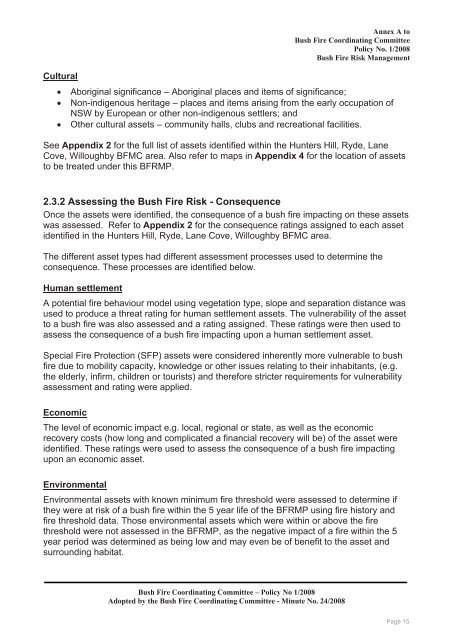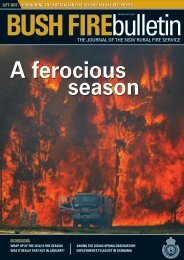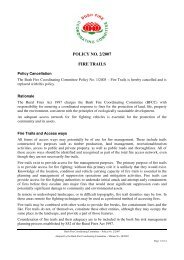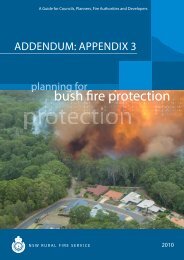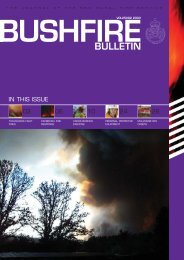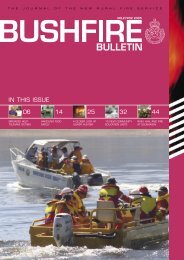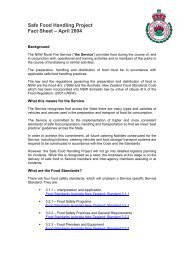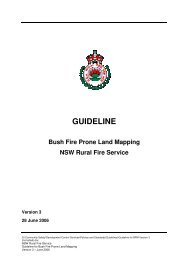Click here to view - NSW Rural Fire Service
Click here to view - NSW Rural Fire Service
Click here to view - NSW Rural Fire Service
Create successful ePaper yourself
Turn your PDF publications into a flip-book with our unique Google optimized e-Paper software.
Annex A <strong>to</strong><br />
Bush <strong>Fire</strong> Coordinating Committee<br />
Policy No. 1/2008<br />
Bush <strong>Fire</strong> Risk Management<br />
<br />
Aboriginal significance – Aboriginal places and items of significance;<br />
Non-indigenous heritage – places and items arising from the early occupation of<br />
<strong>NSW</strong> by European or other non-indigenous settlers; and<br />
Other cultural assets – community halls, clubs and recreational facilities.<br />
See for the full list of assets identified within the Hunters Hill, Ryde, Lane<br />
Cove, Willoughby BFMC area. Also refer <strong>to</strong> maps in for the location of assets<br />
<strong>to</strong> be treated under this BFRMP.<br />
<br />
Once the assets were identified, the consequence of a bush fire impacting on these assets<br />
was assessed. Refer <strong>to</strong> for the consequence ratings assigned <strong>to</strong> each asset<br />
identified in the Hunters Hill, Ryde, Lane Cove, Willoughby BFMC area.<br />
The different asset types had different assessment processes used <strong>to</strong> determine the<br />
consequence. These processes are identified below.<br />
<br />
A potential fire behaviour model using vegetation type, slope and separation distance was<br />
used <strong>to</strong> produce a threat rating for human settlement assets. The vulnerability of the asset<br />
<strong>to</strong> a bush fire was also assessed and a rating assigned. These ratings were then used <strong>to</strong><br />
assess the consequence of a bush fire impacting upon a human settlement asset.<br />
Special <strong>Fire</strong> Protection (SFP) assets were considered in<strong>here</strong>ntly more vulnerable <strong>to</strong> bush<br />
fire due <strong>to</strong> mobility capacity, knowledge or other issues relating <strong>to</strong> their inhabitants, (e.g.<br />
the elderly, infirm, children or <strong>to</strong>urists) and t<strong>here</strong>fore stricter requirements for vulnerability<br />
assessment and rating were applied.<br />
<br />
The level of economic impact e.g. local, regional or state, as well as the economic<br />
recovery costs (how long and complicated a financial recovery will be) of the asset were<br />
identified. These ratings were used <strong>to</strong> assess the consequence of a bush fire impacting<br />
upon an economic asset.<br />
<br />
Environmental assets with known minimum fire threshold were assessed <strong>to</strong> determine if<br />
they were at risk of a bush fire within the 5 year life of the BFRMP using fire his<strong>to</strong>ry and<br />
fire threshold data. Those environmental assets which were within or above the fire<br />
threshold were not assessed in the BFRMP, as the negative impact of a fire within the 5<br />
year period was determined as being low and may even be of benefit <strong>to</strong> the asset and<br />
surrounding habitat.<br />
<br />
Bush <strong>Fire</strong> Coordinating Committee – Policy No 1/2008<br />
Adopted by the Bush <strong>Fire</strong> Coordinating Committee - Minute No. 24/2008


